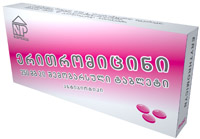Erythromycin 250 mg #20 Tab

Using instruction
"ERYTHOMYCIN"
,,ERYTHROMYCIN''
Covered pills
Pharmacological group: Macrolide group antibiotic.
Composition:
Erythromycin stearate - 250mg.
Aiding substances: Lactose, starch, magnesium carbonate, polyvinylpyrrolidone, calcium stearate, sucrose, talcum, aerosil, titanium dioxide.
Pharmacological operation:
Erythromycin is a macrolides group antibiotic with bacteriostatic action. Its antimicrobial effect is conditioned by bacterial protein synthesis procedure violations.
Some gram-positive (penicillinase productive and non- productive Staphylococus spp Streptococcus spp; among them S. Pneumoniae, Clostridium spp; Bacillus anthracis, Corinebacterium diphtheriae) and gram-negative (Neisseria gonorrhoeae, haemophillus infuenzae, Bordetella pertussis, Brucella spp; Legionella spp;) bacteria are sensitive toward the preparation, also Mycoplasma spp; Chlamidia spp; Spirochaetaceae, Rickettsia spp;.
Majority of gram-negative microorganism are resistant toward Erythromycin, among them; Esherichia coli, Pseudimonas aeruginosa, also Shigella spp; Samlonella spp.
Pharmacokinetics: Erythromycin is well absorbed from gastrointestinal tract and reaches in majority of organism's biological liquids. At time of meningitis, preparation access in hematoencephalic barrier increases. Erythromycin is concentrated in the liver tissue and excrete together with bile. Influence of liver function disorder on Erythromycin excretion isn't found.
At time of oral intake less than 5% of Erythromycin invariably excreted from kidneys. Erythromycin reaches in placental barrier, but its concentration in fetal plasma is insignificant.
Indication:
Infectious inflammatory diseases caused by microorganisms sensitive to preparation, among them: diphtheria, hoping-cough, brucellosis, legionnaires' disease, tonsillitis, trachoma, scarlatina, pneumonia, multiple bronchiectasis in exacerbation stage, bronchitis, septic condition, erysipelas, mastitis, osteomyelitis, cholecystitis, purulent otitis and other purulent inflammatory processes.
Contra-indication:
- Heightened sensibility toward macrolide group antibiotic;
- Liver function severe disorder;
- Anamnesis - jaundice.
Safety measures:
At time of Erythromycin there may develop microorganisms' stability toward antibiotics. Herewith, there is across resistance toward macrolide group other antibiotic. Preparation is safely prescribed to those patients who have liver or kidneys functional disorder.
Erythromycin taking is forbidden together with milk or milk products.
Order of reception and dosage:
For adults: single dose makes up 250mg. At time of severe disease - 500mg. every 4-6 hours, 1-1,5 early before eating or 2-3 hours after eating.
In adults the highest single dose is 500mg, but round-the-clock dose - 2-3 g (2000-3000mg).
For children: from 4 months till 18 years - 30-50mg/kg. weight during round-the-clock, considering disease current and patients' age. Round-the-clock dose is distributed for 2, 3 or 4 taking (every 6 hours 4 times during round-the-clock, every 8 hours 3 times in round-the-clock during and in 12 hours - 2 times in round-the-clock).
Duration of treatment is depend on disease form and severity and makes up 5-14 days.
Side-effects:
Nausea, vomiting, diarrhea, cholestatic jaundice, allergic reactions sometimes (rash, urticaria, anaphylactic shock). Long term usage of preparation may cause liver functional disorder, oral cavity candidiasis.
The pregnancy and lactation period:
Erythromycin will pass placental barrier, so preparation prescription at pregnancy Erythromycin may be taken only when the expected advantage for mother exceeds potential risk for the child;
Erythromycin gets to mother's milk and consequently it is necessary to interrupt chest feeding during treatment.
Influence on ability of management of vehicles and mechanisms:
Erythromycin does not operate on ability of driving vehicles and mechanisms.
Interaction with other medical preparations:
Preparations, that increase acidity of gastric juice, also acid juices cause inactivity of Erythromycin.
Preparation taking isn't recommended with acetylcysteine, lincomycin, clindamycin. Erythromycin reduces theophyline clearance and obstacles carbamazepine metabolism, increases its concentration in serum and potential toxicity.
Erythromycin may reduce indirect anticoagulants (warfarin) clearance and cause hypoprothrombinemic effect exponentiation. Simultaneous application of ergotamine and Erythromycin may develop peripheral vasospastic effect. Preparation inhibits cyclosporine elimination and causes increase of creatinine in plasma. Erythromycin and oleandomycin have cross resistance.
Packing: 10 tablets on blister; 2 blisters in a cardboard box.
Issue: pharmaceutical product group II (issued by the doctor's prescription).
Shelf life: 2 years.
Storage conditions: Store at a temperature 15-25°C.
In case of validity term expiration or visual survey of defects detection - the preparation using is inadmissible.
Produser:Ltd "Neopharmi".
12th km, David Agmashenebeli alley, Tbilisi, Georgia
Tel/Fax: +995 (32) 59-57-90; 59-64-46.

